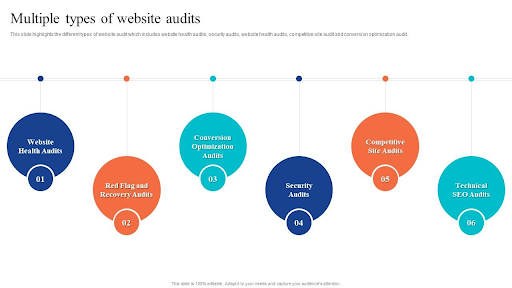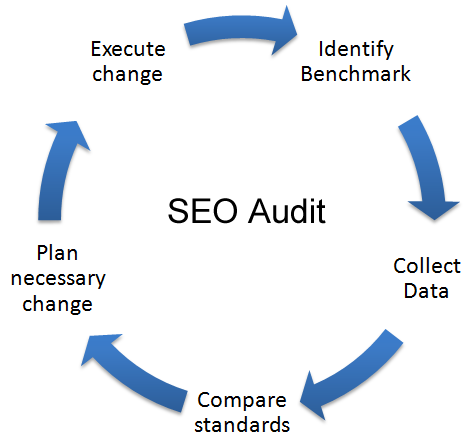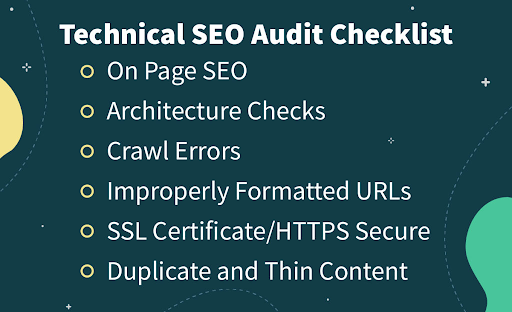SEO Audit Essentials: A Practical Guide for Website Optimization
November 28, 2023
Prashant Shukla
Summary: Highlighting the importance of SEO audit, its benefits, and the steps to be followed for an effective audit.
Search Engine Optimization (SEO) is essential to the success and enhanced online visibility of any website. SEO’s main aim is to help you optimize your website to make it compliant with search engine guidelines, thus compelling it to keep shining the spotlight on your online property. To stay ahead in the digital world, organizations and website owners must analyze and adjust their SEO efforts on a regular basis.
The SEO audit, a thorough review of your website’s performance, structure, and content is a critical tool in this process. A website SEO audit determines how effectively your website is optimized for search engines. It identifies issues that may be harming the site’s rankings and suggests ways to fix them. This comprehensive insight into your website’s performance enables you to take the corrective measures required to bring your website to the good graces of the search engines.
A successful SEO audit is a proactive method to increase the visibility and performance of your website in search engine results. You can ensure that your website remains competitive and attracts organic traffic by analyzing and optimizing different sections and elements of your site. In the ever-changing digital landscape, regular SEO audits are critical for adapting to algorithm changes and staying ahead of the competition.
In this article, we will walk you through the steps of doing an efficient SEO audit to increase the visibility of your website and drive or increase organic traffic.
Types of Website SEO Audit

Source: slideteam
A website SEO audit is categorized into ten variants, wherein each SEO audit type focuses on a specific factor of your website. These variants include:
1. Technical SEO audit
As the name suggests, technical website SEO focuses on the technical aspects of your website, which primarily include site speed, mobile responsiveness, crawl errors, XML sitemap, robots.txt file, server response codes, etc. This SEO audit type is typically carried out using Google Search Console, Screaming Frog, and SEMrush.
Additional read: Technical SEO
2. On-page SEO audit
This website SEO audit looks for issues in the on-page elements of your website, primarily meta descriptions, title tags, header tags, URL structure, keyword usage, user experience (UX), and content quality. A few tools used for this process include Yoast SEO, Moz, and SEMrush.
3. Content audit
This SEO audit process analyzes the quality and relevance of your website’s content. A few of the factors taken into account are uniqueness, keyword usage, readability, content strategy, etc.
4. Backlink audit
Analyzing and flagging the quality of backlinks is a key component of a backlink SEO audit. In this process, various tools, such as Majestic, Moz, and Ahrefs are employed to ensure the presence of only high-quality and relevant links, while removing spam links.
5. Local SEO audit
Targets local businesses and evaluates their online presence in local search results. Local SEO audit focuses on five key elements, namely Google My Business optimization, local citations, NAP consistency (Name, Address, Phone Number), customer reviews, and local keyword optimization.
6. e-Commerce SEO audit
Particularly beneficial for e-commerce websites, the e-commerce SEO audit is specific to online stores, addressing elements that impact e-commerce website performance. The analysis focuses on several elements of e-commerce, including product descriptions, product images, user reviews, site structure, internal linking, and checkout process optimization.
7. Competitive SEO audit
A key element of an effective SEO audit strategy, a competitive SEO audit focuses on the SEO strategies of competitors to identify strengths and weaknesses. Competitive SEO audit takes a deep dive into competitor keywords, backlink profile comparison, content strategy evaluation, and identifying opportunities for improvement.
8. Mobile SEO audit
The SEO audit category is employed to address one of the most important factors in SEO, responsive design. The mobile SEO audit analyses and identifies issues with your website’s responsive compatibility. A few factors that are focused on during a mobile SEO audit include mobile responsiveness, page speed on mobile devices, mobile-friendly design, and mobile user experience. Google Mobile-Friendly Test and Google PageSpeed Insights, are some of the tools to ascertain the performance of your website’s responsive design.
9. Penalty and recovery audit
The penalty and recovery SEO audit is conducted when a website is penalized by the search engine. The penalties can be levied for a variety of reasons, including the use of grey/black-hat SEO techniques and other issues. Use Google Search Console to check for penalties, identify low-quality or spammy content and harmful backlinks, and find tips to create an effective recovery strategy.
10. Site architecture and navigation audit
As the name suggests, the site architecture and navigation audit helps analyze your website’s structure and navigation to help improve user experience and enhance search engine crawling. Using Google Search Console and Google Analytics, the site architecture and navigation audit conducts a deep dive into your website’s Site structure, internal linking, breadcrumb navigation, and URL hierarchy.
Importance of an SEO Audit

Source: blackbirdesolutions
It is critical to assess a website’s overall health in order to ensure that the website is functioning optimally, is abiding by search engine guidelines, and to avoid penalties, which can greatly harm the website’s reputation.
You’ll need to do an internal website SEO audit into a variety of elements, such as the sitemap, anchor text, and even social media integration. A comprehensive audit will reveal red-flag issues, including page load time, which is a critical factor in determining your website’s performance.
A key reason to conduct a comprehensive website SEO audit is to ensure that your website isn’t being penalized by the search engine for steps taken intentionally or unintentionally to increase the website’s visibility.
Comprehensive SEO Audit Process

Source: prerender
An in-depth website SEO is a complicated and thorough process that involves multiple steps to gain a deep understanding of your website’s health. The following are the vital steps that should be taken to ensure a successful and effective website SEO audit. Let’s begin!
Indexing issues check
Remember, no matter how well-designed your webpage might be if it’s not indexed in the search engines, then it’s simply lost into the oblivion of the Internet. Checking the indexing status of your web pages is crucial, as the unindexed ones won’t be considered for ranking. Google Search Console is the ideal platform to identify unindexed pages and get them indexed. However, not all pages require to be indexed, as they might be irrelevant to the users. Some of these pages include:
- Admin pages
- Feed pages
- Secondary pages with canonical tags
- Redirecting pages
Identify the site’s duplicate versions
To ensure that the search engine crawls and sees only the optimal version of your website, it’s vital to run a check to identify your site’s duplicate versions. These versions can be running on different URL structures, i.e. WWW, HTTP, or HTTPS (see example below).
- http://www.abc.com
- http://abc.com
- https://www.abc.com
- https://abc.com
Having four versions of the same website confuses the search engine and can lead to a variety of issues, including crawling, indexing, and even rankings, as the search engine will consider them duplicate versions. Identifying site duplicates is a crucial factor in a website SEO audit. Once you’ve identified the duplicate versions, use a 301 redirect to ensure that all other versions bring the user to the one that you want them to.
Site crawl test
A critical step of a comprehensive SEO audit, the site crawl test provides you with valuable insights into the issues plaguing your site and its performance. The site crawl test highlights the issues by providing information on errors, warnings, and notices to enable you to address these concerns. Despite being an SEO audit element, you need not wait for the periodic SEO audit and should run this test as often as possible to keep your website in optimal condition.
Run a ‘manual actions’ check
During the website SEO audit, head to the Google Search Console and check for any ‘manual actions’ initiated by the search engine. These actions can lead to a continuous drop in your website’s ranking and severely affect its search engine visibility. The actions are triggered if your website violates the search engine guidelines, especially if the site has unwanted elements, such as,
- Spam
- Irrelevant and thin content
- Keyword stuffing
- Unnatural links (bought links)
Once identified, fix the issues that have triggered the manual actions immediately, submit a reconsideration request to remove the penalties, and get back into action.
Responsive issues
In today’s day and age, where mobile devices have become the norm, it’s wise to keep your website responsive-design optimized. A mobile-unfriendly website is frowned upon by search engines, as mobile-friendliness is a key determinant for page ranking and its absence degrades the user experience (UX), signaling to the search engine that UX is not a priority for the site. Use Google Search Console to identify the issues with your site’s responsive design, make the necessary fixes, and get it validated by Google to ensure optimal responsive functionality.
Site speed analysis
The page load time of your website is one of the crucial factors determining the site’s search engine rankings, as it directly impacts user experience. The faster your pages load, the more love your site gets from the search engines. Slow page load time leads to a higher user bounce rate. The page load time and its impact on bouse rate is as follows:
| Page Load Time |
Bounce Rate Impact |
| 1 to 3 seconds |
32% |
| 1 to 5 seconds |
90% |
| 1 to 6 seconds |
106% |
| 1 to 10 seconds |
123% |
During the SEO audit, check your site’s page loading speed in the website dashboard and compare the time data with the above table to understand the impact of the results. Keep an eye on the recommendations in the dashboard to take corrective measures to increase your site’s speed and impress the search engines, once again.
Core web vitals
In 2020, Google introduced three new metrics under the banner of Core Web Vitals to score a website’s page load speed and user experience, making them key ranking factors. These three metrics are:
- Largest contentful pain (LCP): The time taken to load the largest element of the page.
- First input delay (FID): The time delay between the first landing of the user on the page and the browser’s response.
- Cumulative layout shift (CLS): Visual stability measurement and shifting of the page layout during user interaction.
Google Search Console becomes your savior again as it displays the results for these metrics for desktop and mobile versions of your website in a consolidated dashboard. Core Web Vitals tool also eases your understanding of the issues by presenting pages with severe issues and the ones with improvement suggestions, separately. Analyze the results and make the necessary adjustments to get your website back on track.
Internal links check
Internal links are crucial for user experience as they are key elements for the site’s navigation, ensuring a smooth user journey, helping the search engines to crawl your website, and establishing your site’s authority.
An SEO audit is incomplete without a thorough internal links check. Analyze the internal link structure to ensure that it is properly structured and offers a smooth user experience. Check that key pages have a sufficient amount of internal connections and that less important pages are not link-stuffed.
Make sure to identify and repair any damaged internal links, as broken links can severely affect the user experience and search engine results. Also, check that deep linking is used when required. Deep linking refers to pointing to specific pages inside a website as opposed to just linking to the homepage.
Check that breadcrumbs are used, if applicable. Breadcrumbs not only improve the user experience but also give more internal links.
Organic traffic analysis
Organic traffic is one of the most important factors that determine your website’s performance and quality. High organic traffic means that your website is performing as expected and is also in the good graces of search engines. Once again, the Google Search console proves to be the ideal tool for understanding the organic traffic trends on your site, analyzing the reasons behind the drop (if any), and taking corrective action to ensure your website is optimized to draw organic traffic.
Competitor analysis
Competitor analysis is a critical part of the SEO audit process as it provides valuable insights into your competitor’s performance and where your website stands against your competitor’s. To ensure an effective competitor analysis, you should focus on the following four factors:
- Content analysis
- Keyword analysis
- Backlink analysis
- Technical analysis
Identify the missing keywords
Yet another crucial SEO audit step, identifying missing keywords from the competitor analysis, helps you to improve the existing content and create new and relevant keyword-rich content that’ll assist in driving more organic traffic to your website. Use competitor analysis tools, such as the Semrush Keyword Gap tool to identify and close the keyword gap by focusing on the ‘missing keywords’. Use these keywords in your content to help increase organic traffic to your website.
Remember that SEO is a continuous process, and frequent audits are critical for maintaining and increasing your website’s search engine rankings. Following the website SEO audit, prioritize and implement changes depending on the issues and opportunities discovered, to get back on Page 1 of the search engine.